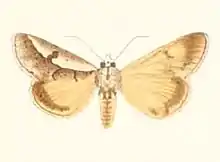Euscirrhopterus poeyi
Euscirrhopterus poeyi, the pullback moth, is a moth of the family Noctuidae. The species was first described by Augustus Radcliffe Grote in 1866. It is found from southern Florida and Mexico, through Central America to Brazil. It is also found in the Caribbean, including Cuba.[1]
| Euscirrhopterus poeyi | |
|---|---|
 | |
| Scientific classification | |
| Kingdom: | Animalia |
| Phylum: | Arthropoda |
| Class: | Insecta |
| Order: | Lepidoptera |
| Superfamily: | Noctuoidea |
| Family: | Noctuidae |
| Genus: | Euscirrhopterus |
| Species: | E. poeyi |
| Binomial name | |
| Euscirrhopterus poeyi Grote, 1866 | |
| Synonyms | |
| |
The wingspan is about 34 mm for females and 38 mm for males.[2] Adults are sexually dimorphic. Males are smaller and their wings are characterized by large areas of hyaline (glass-like) membrane lacking scales. Females are larger without the hyaline membranous areas. The general color is a dark gray brown.[3]
The larvae feed on Pisonia aculeata.[4]
References
- Becker, Vitor O. (2002). "The Noctuoidea (Lepidoptera) from Cuba described by Herrich-Schäffer and Gundlach in the Gundlach Collection, Havana" (PDF). Revista Brasileira de Zoologia. 19 (2): 349–391. Archived (PDF) from the original on November 29, 2012.
- "931973.00 – 9307.1 – Euscirrhopterus poeyi – Pullback Moth – Grote, 1866". North American Moth Photographers Group. Mississippi State University. Retrieved December 2, 2018.
- Noctuidae of North America
- Search Results Euscirrhopterus poeyi. HOSTS - a Database of the World's Lepidopteran Hostplants. Natural History Museum, London. Retrieved December 2, 2018.
This article is issued from Wikipedia. The text is licensed under Creative Commons - Attribution - Sharealike. Additional terms may apply for the media files.